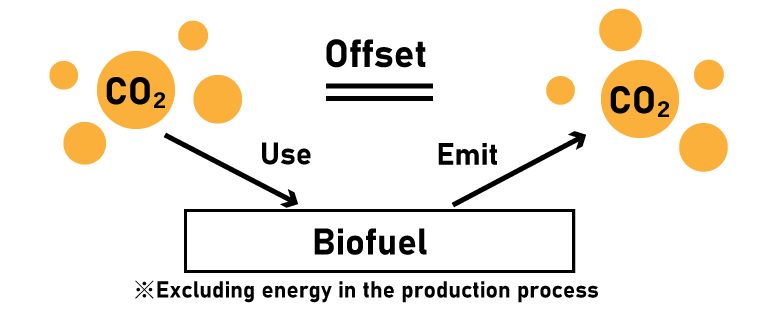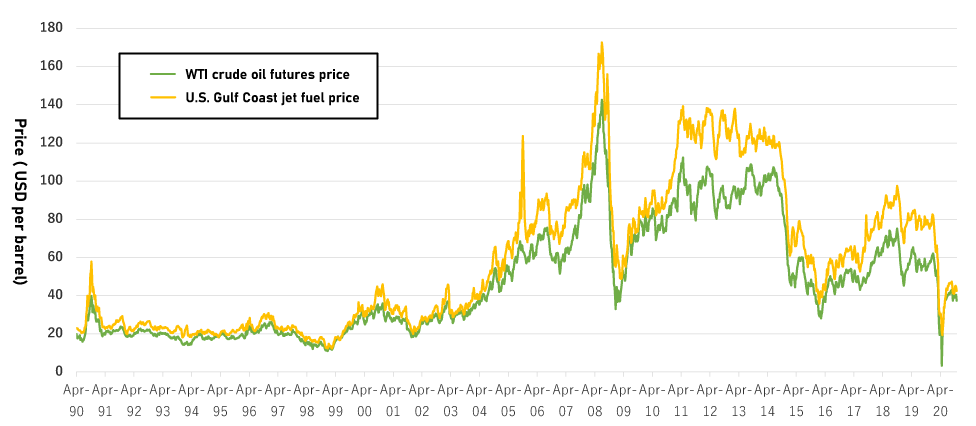


Euglena Fuel
In recent years, there has been a growing interest in environmental protection and countermeasures against global warming, and biofuels are receiving increasing attention. It is believed that global warming will cause problems directly related to our daily lives, such as abnormal weather, sea-level rise, and food security crisis. In his policy speech on October 26, 2020, Suga, Prime Minister of Japan, declared, "I hereby declare that Japan aims to reduce its greenhouse gas emissions to zero by 2050, that is, to achieve a carbon-neutral, decarbonized society by 2050." In this trend, expectations are rising for euglena fuel, a biofuel.
Production of Euglena Fuel
Jet fuel and diesel fuel are two of the most suitable fuels that can be produced from euglena. As shown in the chart below, the property of petroleum fuels is based on the number of carbon atoms per molecule of hydrocarbon. The higher the number of carbons, the more viscous the heavy oil, and the lower the number, the more volatile the light oil.

In an environment with sufficient oxygen, euglena synthesizes glucose through photosynthesis and stores it as a polysaccharide called paramylon. However, in an environment without sufficient oxygen, they break down the paramylon stored in its body to produce fats and oils called wax esters.

To produce euglena fuel, wax esters are extracted using solvents, and then hydrogenated to remove excess oxygen. The resulting oil has a carbon number of around 15, which makes it suitable for jet fuel and diesel fuel. The properties of the fuel produced in this way can also be chemically altered to make oil with other carbon numbers.

Differences from Other Biofuels
Hydrocarbons, which are the main component of crude oil, have been produced over hundreds of millions of years by plants through photosynthesis and reforming. On the other hand, biofuels are made from carbon dioxide in the air, therefore the carbon dioxide emitted during combustion is offset. Therefore, apart from the energy required during the production process, biofuels do not cause the carbon dioxide concentration to rise.

In addition, biofuels do not emit sulfur oxides (SOx), which are a cause of air pollution. For these reasons, biofuels are expected to become an alternative energy source to fossil fuels such as petroleum, coal, and natural gas.
Problems Faced by Existing Biofuels
Bioethanol, a typical biofuel, is made from sugarcane and corn, and has been attracting attention as an alternative fuel to gasoline since the oil crisis of the 1970s. Biodiesel fuel, made by processing rapeseed oil and palm oil, is used as an alternative fuel to light oil.

These biofuels were developed and put to practical use relatively earlier than other biofuels, and they are called first-generation biofuels. It was feared that these biofuels would not be widely used due to cost and other issues. However, countries such as the U.S. and Brazil promoted publicly the use of biofuels by obligating the blending of biofuels with gasoline and paying subsidies, and as a result, the production of biofuels gradually expanded.
The widespread use of biofuels, such as bioethanol, is a step forward in the fight against global warming. However, the first-generation biofuels have some big problems.
As bioethanol became more widespread, the prices of sugarcane and corn, the raw materials, rose. Biodiesel also attracted attention as a recycled fuel when it was produced mainly by processing waste oil. However, as demand for biodiesel increased, especially in Europe, there was a shortage of oil as a raw material, and in recent years, the area planted with oilseed rape and other crops has been increased.
Generally speaking, when the population increases, the labor force increases, and the demand for food increases. Therefore, the cultivated area of the fields that produce food increases, and when the cultivated area increases, the food production increases, and therefore the population also increases.
For this reason, it is difficult to imagine a situation in which there is only a surplus of cultivated area. If crops are used as raw materials for biofuels, the supply of crops as food will decrease and the price of crops will rise.

In addition to preventing such a situation, since the supply of bioethanol could no longer keep up with the demand, the mandatory blending ratio for gasoline in Brazil was lowered from 25% to 20% in 2003. Although such actions have been taken, in these years of globalization and international division of labor, wealthy countries may take food from countries with less economic power in order to purchase fuel. In addition, forests in areas such as the Amazon are being cut down in order to expand cultivated land to meet the increasing demand for biofuels, and some have pointed out that "the spread of biofuels for the sake of the environment will lead to accelerated deforestation".
For these reasons, second-generation biofuels are being developed from non-food crops such as Pongamia and jatropha, thinned wood, waste wood, rice straw, industrial and domestic waste, etc. However, some argue that the cultivation of these crops requires farmland, and competition with food crops can only be avoided on the surface. There is also the opinion that competition with food crops can only be avoided on the surface. In the case of using waste as a raw material, the supply of garbage is limited and production is not stable. In the case of cellulose-rich raw materials such as thinned wood and waste wood, they have to be broken down into sugar using chemical treatment or microorganisms, therefore the productivity as a business is not good.
In contrast to first- and second-generation biofuels, which have these problems, euglena fuel has no risk of diminishing the food supply and can be produced with high efficiency, with the amount of oil produced per hectare being 10 to 15 times that of palm oil (approximately 6 tons per hectare per year). For this reason, along with other algae-based fuels, expectations are rising for third-generation biofuels as an alternative to petroleum.
Advantages in the Refining Processes
Biodiesel fuels made from waste oil and rapeseed oil use Fatty Acid Methyl Ester (FAME), which has similar properties to light oil. FAMEs are refined through a process called ester exchange, in which methanol is added to triglycerides, a vegetable fat. However, as much as 10% by weight of glycerin is produced in this process.

However, there is an oversupply of glycerin, and it is often discarded. On the other hand, the wax ester used in euglena fuel does not produc glycerin in the refining process. The fact that its molecular structure is similar to that of FAME is also an advantage in its use as a biofuel.
Also, since euglena does not have cell walls like oilseed rape, no cellulose remains in the manufacturing process, which simplifies processing and has advantages in cost.
Price of Euglena Fuel and Value as a Business
Rising Prices of Fossil Fuels
In recent years, the emergence of shale oil and shale gas, improvement in mining technology, and other factors have alleviated fears of a shortage in the supply of energy resources, however, the price of crude oil has risen significantly compared to around the 1990s. Jet fuel prices are also rising due to the expected increase in demand for aviation fuel from the expansion of LCCs and the growing demand for aviation in developing countries.

When the price of crude oil is around 75 U.S. dollars per barrel, euglena fuel can compete well with petroleum and other fossil fuels. Even if the price of crude oil is a little higher than that, the spread of euglena fuel is expected to increase because of government support such as environmental regulations and subsidies, and significant reductions in refining costs through large-scale production.
The cost of producing fuel at the demonstration plant run by Euglena, the company developing and demonstrating euglena fuel, is 70 yen per liter for the raw material and 9,930 yen for the refining cost, but it is known that the refining cost can be reduced to less than 20 yen if economies of scale are applied through large-scale production.
Advantages of Euglena Fuel
The uses of euglena are not only for fuel, but also for food, feed, carbon emissions trading, and many other ways. Therefore, it is possible to produce other products at the same time as producing euglena fuel, leading to higher profits.Global Warming Countermeasures in the Airline Industry
As environmental regulations in many countries progress, the airline industry is working to reduce greenhouse gas emissions, and biofuels such as euglena fuel are expected to be actively used.
At its 2016 Assembly, the International Civil Aviation Organization (ICAO) adopted a Growth Scheme that states that greenhouse gas emissions will not increase after 2021. All Nippon Airways (ANA) has provided support to Euglena, which is running a euglena fuel business, and Japan Airlines (JAL) has invested in a U.S. company engaged in the production of biojet fuel from general waste.
The advantages of using biojet fuel, such as euglena fuel, are not only in complying with environmental regulations. Existing jet fuel has the risk of price fluctuations, such as a price hike due to a decrease in supply caused by a rise in crude oil prices that prioritizes the production of highly profitable diesel fuel and other fuels, and the risk of being affected by exchange rates at the time of transactions.

In contrast, biofuels do not have these risks because their production and supply are stable and their prices are also stable. This is a big advantage for airlines. In addition, the increased cost of using biofuels can be recovered through fuel surcharges. For these reasons, biofuels, including euglena fuel, are expected to become more popular in the airline industry.
Current Status of Euglena Fuel Business
Euglena is a Japanese company that is engaged in the euglena fuel business. In October 2018, Euglena completed the Japan's first biojet and diesel fuel production demonstration plant in Yokohama City. It announced the ''GREEN OIL JAPAN'' declaration, sponsored by the city of Yokohama, Chiyoda Corporation, ITOCHU ENEX, Isuzu Motors, All Nippon Airways, and Hirojiren. The declaration states that the goal is to "make Japan a leading biofuel country". The declaration is also supported by many companies and organizations, including East Japan Railway Group, SHIMIZU CORPORATION, Shinnihon Kasei, SEIBU BUS, DENSO, FamilyMart, Ishigaki City, Saga City, and others.
Acquired International Standard "D7566"
In January 2020, the euglena jet fuel produced by Euglena acquired the international fuel standard "D7566" set by ASTM International (formerly the American Society for Testing and Materials). This fuel is made by mixing euglena with waste food oil. Fuels produced in compliance with this standard will be treated in the same way as petroleum-based jet fuel and can be used in commercial aircraft on an international scale.

Formerly, five biojet fuels made from sugar cane and other raw materials were approved for "D7566. In Japan, the Ministry of Land, Infrastructure, Transport and Tourism (MLIT) promulgated and enforced a partial amendment to the "Handling of Alternative Jet Fuels ( ASTM D7566 Standard) for Use in Aircrafts" in February 2020, allowing the use of this euglena jet fuel in Japan.
Adopted as a NEDO Public Project
In October 2020, Euglena's euglena jet fuel business and research and development on microalgae for fuel were selected by the New Energy and Industrial Technology Development Organization (NEDO) for its publicly offered projects, "Biojet Fuel Production Technology Development Project" and " Building of Supply Chain Models and Development of Microalgae Fundamental Technology through Demonstrations."
The project period is from 2020 to 2024, and the "Biojet Fuel Production Technology Development Project" has been selected jointly with ITOCHU Corporation, DENSO Corporation, and Mitsubishi Chemical Corporation, and the grant is expected to be between 500 million yen to 3 billion yen over five years. Also, in the ''Building of Supply Chain Models and Development of Microalgae Fundamental Technology through Demonstrations'', although the amount of the grant is undisclosed, it is expected to be 6.85 billion yen over five years jointly with companies that have been selected for other themes.

Euglena, in collaboration with ITOCHU Corporation, has been conducting demonstration research on mass cultivation for the stable supply of Euglena in Indonesia and Colombia from the perspective of production costs and cultivation environment. Euglena will continue to promote the project in Indonesia as a publicly offered project by NEDO, which was adopted this time.
Other Projects
Euglena is also working on various other projects in the field of diesel fuel, such as supplying euglena diesel fuel for the operation of shuttle buses between the Fujisawa Plant of Isuzu Motors and Shonandai Station, the closest station to the plant, and conducting a navigation test using a sightseeing boat of Yaeyama Kanko Ferry (Ishigaki City, Okinawa Prefecture) in September 2020.
This site is participating in the 23nd Japan Junior high school/high school Web contest(第23回全国中学高校Webコンテスト).
